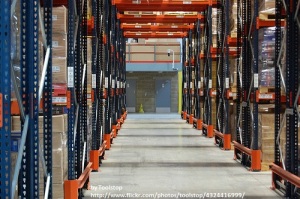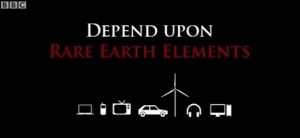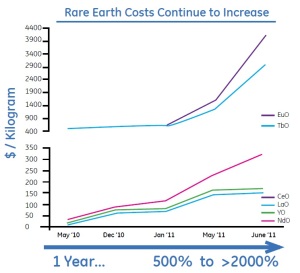Archive
Guess who is the leading global LED exporter
Today I went to a mall to buy some very last minute Christmas gifts. After a while noticed a nice lamp (the one in the picture).
Good quality and design and also the price was very affordable (about 15 €). The nice thing is that on the base it has a solar-fotovoltaic panel charging a battery and on top there is a small higly lighting LED (light-emitting diode).
I was amused to see combined together two technologies (solar-fotovoltaic panels) and LED, that are often advocated as the future of green technologies. According to McKinsey & Company and Conference Board (2007) LED is one of the most promising technologies in terms of greenhouse gas emissions. Also, the market of LED is growing rapidly spuring the whole supply chain (yes, LED are small but rather complex products – see Gereffi and Lowe, 2008)
So, I was even more surprised when I noticed that the lamp was manufactured in P.R.C. (People Republic of China) and, once home, I went to the UN Comtrade website to see who are the leading global exporters of LED.
I summarized the results in the following pie chart…pretty surprising, isn’t it?
 So, China controls the 35% of the global exports of LED. I guess that if we would consider the totality of LED manufactured in the world the picture wouldn’t change much.
So, China controls the 35% of the global exports of LED. I guess that if we would consider the totality of LED manufactured in the world the picture wouldn’t change much.
References
McKinsey & Company and Conference Board. (2007). Reducing US Greenhouse Gas Emissions: How Much at What Cost? available at: http://www.mckinsey.com/Client_Service/Sustainability/Latest_thinking/Reducing_US_greenhouse_gas_emissions
Gereffi, G. & Lowe, M. (2009), Manufacturing Climate Solutions – LED Lighting, available at: http://www.cggc.duke.edu/environment/climatesolutions/
Sustainability in the supply chain and the new car paradox
There is an interesting report by McKinsey Quarterly (The business of sustainability: available here). More than 3,000 executives from many different industries replied to a survey providing information on how much sustainability represents a business prioirity and which actions are taken.
Of course, we immediately looked at supply chain related aspects!
First interesting thing: managing impact of products through the value chain is at the 10th place of the concerns and motivations to implement sustainability (only 28% of the companies marked this item), after other reasons like: reducing energy and water use, waste, corporate reputation and respond to regulatory pressures.
It is therefore not surprising that supply chain management is one of the last business processes in which sustainability has been completely or mostly integrated.
There can be several reasons for this, not last, that controlling suppliers and suppliers’ suppliers is more difficult than controlling your own company. And this is even more true when suppliers are global.
However, this remains a key point: can a company declare to be sustainable if it has no clue about what is happing in its supply chain? Maybe I can replace my machineries to consume less energy, but how much energy and CO2 has been emitted to make the new machineries?
This can also be called the “new car paradox”:
Making a new car creates as much carbon pollution as driving it, so it’s often better to keep your old banger on the road than to upgrade to a greener model (The Guardian, Green Living Blog)
To me sustainability should be a matter “global omptimization” and not “local optimization”. Otherwise it is like reducing your inventories by moving them to your supplier rather than work together to reduce them and have a real benefit.
So, it seems that there is a lot of effort to be made by research to produce methodologies of evaluation that take into consideration the whole supply chain. From the other side, companies should put more effort to look also outside their bonduaries.
The good news is that some companies are actually doing that. Going back to the McKinsey survey, about 10% of the interviewed companies, the so called sustainability leaders, put a lot of effort on analyzing the product impact along the supply chain…with good returns!
Santa is coming…I can see his footprints…
 Just five days are left before Santa comes. So it is time to make a final count of what Santa is doing for us. Besides all the presents he is going to delivery, the funny old man is going to win the prize for the largest carbon footprint in history. Ethicalocean decided to make a few estimations of Santa’s Carbon Footprint. Due to his very long trip, in one night Santa releases almost 69.4 million metric tons CO2 (similar to what Qatar does in one year). Most of this is due to the life cycle of toys, but also the manufacturing of all cookies he is going to eat, all the wrapping paper he is going to use, etc. have a significant account. So what can Santa do in year 2011? Sustainable innovation is the buzzword: change the old fashioned sleigh with a new one more efficient and (why not?) electricity powered, avoid leaving coal to naughty children but some other alternative form of energy, use recycled paper for wrapping presents. And what can you do to help Santa? Maybe leave only local milk and cookies for the old man?
Just five days are left before Santa comes. So it is time to make a final count of what Santa is doing for us. Besides all the presents he is going to delivery, the funny old man is going to win the prize for the largest carbon footprint in history. Ethicalocean decided to make a few estimations of Santa’s Carbon Footprint. Due to his very long trip, in one night Santa releases almost 69.4 million metric tons CO2 (similar to what Qatar does in one year). Most of this is due to the life cycle of toys, but also the manufacturing of all cookies he is going to eat, all the wrapping paper he is going to use, etc. have a significant account. So what can Santa do in year 2011? Sustainable innovation is the buzzword: change the old fashioned sleigh with a new one more efficient and (why not?) electricity powered, avoid leaving coal to naughty children but some other alternative form of energy, use recycled paper for wrapping presents. And what can you do to help Santa? Maybe leave only local milk and cookies for the old man?
By the way… Merry Xmas!
Italian manufacturing companies are still going global, but…
 Yesterday ISTAT (the Italian National Institute of Statistics) released the results of a research on Italian multinational companies (sorry the page is still in Italian). The research considered 6,173 Italian multinational companies and how they have evolved in the last years (the time frame is 2009 – 2011). Several interesting results are in the report but I was interested by two elements. First of all, in the last two years companies have increased their investments abroad; mainly these investments have been concentrated in Romania, Brasil and China (two of these countries are characterized by a very low cost of labor. At first I interpreted this results as Italian companies moving their production units abroad to reduce costs, and I admit I was somehow annoyed by this evidence. Quite interestingly however these companies report that the main benefits of having foreign branches are (in order of importance – in brackets the frequency of the element): access to new markets and local services for customers (78.7%), logistics and distribution (56.6%), labor cost (42.1%), access to competences (41.9%), new product development (41.3%). Italian companies have indeed invested in manufacturing activities abroad but mainly to expand their markets and not to abandon their country. I see this result with optimism; now it is time to see if we will be able to make ends meet…
Yesterday ISTAT (the Italian National Institute of Statistics) released the results of a research on Italian multinational companies (sorry the page is still in Italian). The research considered 6,173 Italian multinational companies and how they have evolved in the last years (the time frame is 2009 – 2011). Several interesting results are in the report but I was interested by two elements. First of all, in the last two years companies have increased their investments abroad; mainly these investments have been concentrated in Romania, Brasil and China (two of these countries are characterized by a very low cost of labor. At first I interpreted this results as Italian companies moving their production units abroad to reduce costs, and I admit I was somehow annoyed by this evidence. Quite interestingly however these companies report that the main benefits of having foreign branches are (in order of importance – in brackets the frequency of the element): access to new markets and local services for customers (78.7%), logistics and distribution (56.6%), labor cost (42.1%), access to competences (41.9%), new product development (41.3%). Italian companies have indeed invested in manufacturing activities abroad but mainly to expand their markets and not to abandon their country. I see this result with optimism; now it is time to see if we will be able to make ends meet…
It is also important to consider that going global is a strategical decision and companies making this decision with limited attention can be highly risky. In a paper, we recently showed that choosing localization of production without a strategical approach has a direct impact on operational performance. So pay attention when you move production that you have clear in mind why you are doing that.
Source:
Golini R., Kalchschmidt M., Threats of sourcing locally without a strategic approach: impacts on lead time performances, Reiner G. (Edited by), Rapid Modelling for Increasing Competitiveness, 2009, IV, 277-292, Springer
I have 69 slaves working for me
I discovered recently that my family and I are responsible for 69 slaves working all over the world to have us dressed, fed, provided with electronics and games, covered with jewels and precious goods. Slavery Footprint allows you to estimate the number of people that are involved in manufacturing components you purchase based on your life style. Besides the way in which this estimation is done (the methodology section states that some of the weights are based on focus group analyses) it is quite interesting the main areas that contribute to my “unintentional slavery”. Children account the most, mainly for diapers and toys, but also dresses and medicine are rather critical. Cars and home are other two rather important sources of slavery. Interesting my “slavery supply chain” is concentrated in Asia (mainly China and India), but also Africa and (surprisingly Australia) are not new to this problem. If you take a few minutes to go on the site it may be interesting for you to benchmark.
In general this site arises another sustainable issue: the social impact of supply chains. In a paper we presented at the annual meeting of the Production and Operations Management Society (POMS) we analysed the issue of the trade-off among economic, environmental ad social sustainability. Some sustainability critical points are shared by several actors along the supply chain, thus it is important to look at the whole chain when addressing such problems. However, environmental sustainability actions often provide benefits also on economical and social performance. On the contrary, social sustainability actions can negatively impact economical performance.
I consider the issue a complex one: it is out of question that slavery is something we all regret, but to which extent would you be willing to give away your tablet in order to improve your slavery footprint? Is there a real market potential for socially sustainable goods?
From:
Golini, R., Kalchschmidt, M., 2011. Sustainability in the food supply chain: evidences from the Italian beef industry. POMS 22nd Annual Conference. Reno, Nevada, U.S.A. April 29 to May 2, 2011.
Sources:
Moderating the impact of global sourcing on inventories through supply chain management
I n recent years, companies have paid growing attention to supply chain management at a global level. With regard to the upstream part of the supply chain, the need for better suppliers, the research into specific competences and concerns related to international competition have forced companies to improve their ability to cope with suppliers located in different countries around the world.
n recent years, companies have paid growing attention to supply chain management at a global level. With regard to the upstream part of the supply chain, the need for better suppliers, the research into specific competences and concerns related to international competition have forced companies to improve their ability to cope with suppliers located in different countries around the world.
One of the main issues related to the geographical distance of suppliers is higher inventory levels primarily because of longer and more uncertain lead times.
However, a work published by Golini and Kalchschmidt in 2011 on the International Journal of Production Economics demonstrates that companies can significantly limit this effect by means of specific investments in the supply chain and in their relationships with suppliers. The empirical analysis is based on data from the last edition of the International Manufacturing Strategy Survey (IMSS), a database of more 700 companies in the assembly manufacturing industry from more than 20 countries.
We conclude that global sourcing companies tend to invest in restructuring supply strategy and supplier portfolios and in vendor rating and supplier development since and they can gain a beneficial effect on inventory levels. However, an effort to increase integration and coordination with suppliers, even if more difficult in a global sourcing context, can bring about further improvements.
From:
Golini, R., Kalchschmidt, M., 2011. Moderating the impact of global sourcing on inventories through supply chain management. International Journal of Production Economics 133, 86-94.
Sustainability and security issues in Rare Earth supply chains
 A nice video of June 16th 2011 by BBC News of points out issues related to Rare Earth Elements (for instance Ores, Concentrates, Compounds, Oxides and Metals.)
A nice video of June 16th 2011 by BBC News of points out issues related to Rare Earth Elements (for instance Ores, Concentrates, Compounds, Oxides and Metals.)
These materials are always more used in many consumers products (for instance: electronics, batteries, lenses, medical devices) and in many high-efficiency products (for instance: flat panels television, generators for wind turbines, efficient electric motors, efficient light bulbs). Toyota Prius has more than 25 pounds of lanthanum in its nickel-metal hydride battery.
However, several sustainability and security issues are related to the adoption of these materials.
- China has almost the monopoly (95-97% of the global production) of the production of these Rare Erath Elements and has been imposing tariffs and decreasing quotas on its rare earth exports for several years
- Demand for rare-earth metals is estimated around 134,000 tons in 2009, and only 124,000 tons have being produced. By 2012, demand will reach 180,000 tons, which could exhaust the world’s remaining inventory
- Prices are very variable and, generally, soaring
- A lot of water, acid and electricity has to be used in to extract and manufacture rare earhts
- Workers might be exposed to radioactive material
- Only low wages make economically efficient the production of Rare Earhts
Companies are worried about the situation. General Electric, about the production of efficient light bulbs that involve the use of rare earths, has a dedicated web page. In a recent note, Gerenal Electric also reported the trend of soaring prices of Rare Earths.
From a supply chain perspective, companies should:
- Secure the supplies through partnerships with suppliers
- Hedge price variability through financial instruments
- Forecast needs and order with advance
- Were possible assess suppliers’ sustainability performance
- Design products with less need of rare earths and more easy to be recycled
- Increase alternative supply sources (e.g. from reciclying)
Sources:
http://www.bbc.co.uk/news/world-asia-pacific-13777439
http://www.economist.com/blogs/babbage/2010/09/rare-earth_metals
Product safety in global supply chains
Recently an interesting piece of work appeared in the Journal of Operations Management (http://www.sciencedirect.com/science/article/pii/S0272696311000945). The paper reviews the topic of product safety and security in several industries (i.e. food, pharmaceutical, medical, consumer products). A key concern of authors is that product safety becomes a major concern in our economy where most of manufacturing activities are outsourced and thus making traceability and control a real challenge. Recent cases such as Toyota massive recalls (http://www.toyota.com/recall/ , video http://www.youtube.com/watch?v=NDYou3B8-hs) or Fischer Price / Mattel ones.
In the last five years the list of product safety issues is rather disappointing.
| Year | Industry | Incident | Effects |
| 2011 | Food | E.coli contamination of bean sprouts | 37 people died 3.000 people sickened 210 million € for farmers aids |
| 2011 | Medical devices | Balloon catheter | No injuries 18.000 recalls |
| 2011 | Medical devices | Surgical graft | No injuries 3.000 lawsuits |
| 2008-2011 | Automobiles | Toyota | 9 million cars recalled worldwide |
| 2006-2011 | Notebook batteries | Sony | 4 million batteries |
| 2008-2009 | Food | Salmonella in peanut butter | 9 deaths 637 people sickened 4.000 products affected |
Table: recent product safety cases (adapted from Marucheck et al. 2011)
Industrial companies have to face relevant challenges if they want to keep consumers really at the center of their strategy. From a supply chain management perspective attention should be devoted to:
- Relative benefits of vertical integration versus outsourcing with respect to safety. Usually focus is given toward purchasing costs when suppliers have to be selected but “some low-cost suppliers are really high-cost suppliers when the expected costs of safety risks are considered” (Marucheck et al. 2011). In this light total cost (or total sourcing) models should be considered so to address product safety completely
- Controlling and monitoring suppliers for product safety. The adoption of certification programs and testing rules can contribute to the mitigation of product safety issues. Real-time monitoring of manufacturing provided by information technologies can be beneficial too.
- Suppliers education. Frequently issues with suppliers are not the result of intentional violation of rules, but simply are due to lack of knowledge of the implications of certain behavior. When buyers leverage more on cooperation in the relationship instead of coercion, suppliers tend to be more compliant (Jiang, 2009). Training the supplier is an effective way in which both the supplier relationship and its compliance can be positively affected.





